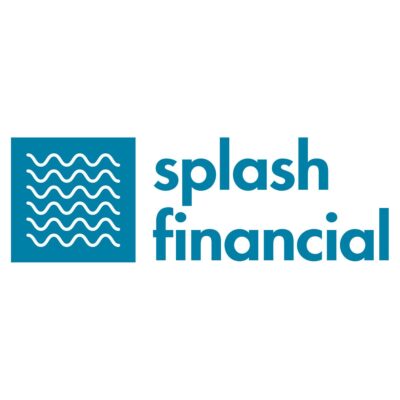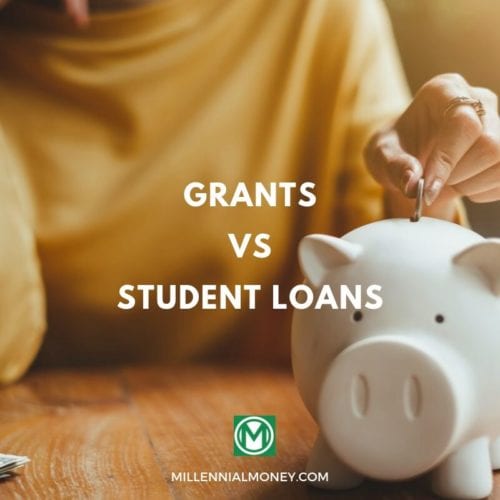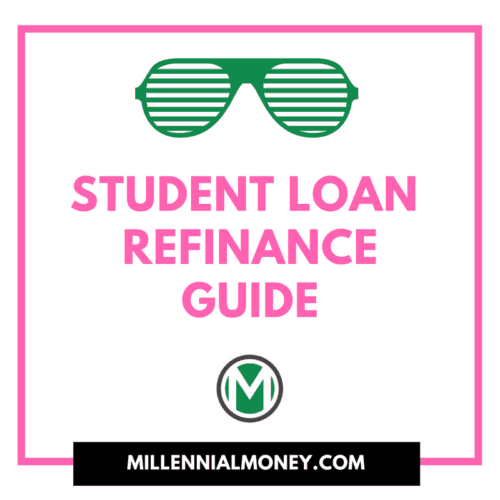Figuring out how to fund college can feel like finding your way through a maze. A high-pressure, high-stakes maze at that.
Studies show that those who have a four-year degree significantly outearn those with lower levels of education prior to age 64 — even when you account for the costs of that degree. But the degree is prohibitively expensive.
If you’re like most Americans and don’t have the money on hand to pay tuition in cash, you may find yourself asking, ‘How, exactly, do student loans work?’
Guide to How Student Loans Work:
Student Loans vs Grants and Scholarships
Ideally, you would be able to fund your entire collegiate education through grants and scholarships.
Grants, which are usually needs-based, and scholarships, which are usually merit-based, are free sources of money that do not have to be repaid as long as you live up to your end of the academic bargain.
However, many students will find themselves with a remaining balance on their tuition bill even after scholarships and grants.
If you don’t have the cash to float the semester, you’re likely going to have to take out student loans in order to finish college traditionally.
When you take out a student loan, you are borrowing money for school. This money will eventually have to be repaid with interest.
Learn More: Read our full article on Grants vs. Student Loans.
Federal vs Private Student Loans
There are two types of student loans: Federal and Private.
Historically, federal student loans have tended to come with lower annual percentage rates (APRs) than those on the private market, though that is starting to change for some highly qualified borrowers with the advent of marketplace lenders.
These internet-based lenders run with lower overhead, allowing them to offer lower interest rates to qualified borrowers.
Federal student loans come with other potential advantages such as repayment plans based on your income, forgiveness, and deferment.
Types of Federal Loans
There are several types of federal loans available to both students and their parents. Which loan is the best for you will depend on your individual financial circumstances and professional goals.
Direct Subsidized Loans
In order to qualify for Direct Subsidized Loans, you must be an undergraduate student who demonstrates a financial need as determined by the Free Application for Federal Student Aid (FAFSA).
Your school will then determine how much you are eligible for — this number can be less than your financial need, but not more.
As you’re working your way through school, the government will pay the interest on your loans to prevent your principal balance from inflating.
Just ensure your enrollment status doesn’t fall below half-time or you will disqualify yourself from this benefit.
The government may also pay your interest if you are in a period of deferment or during the first six months after you graduate.
Direct Unsubsidized Loans
If you do not qualify for subsidized loans or find yourself short on your tuition bill even with their help, you may find yourself looking at an offer for Direct Unsubsidized Loans.
The amount you can borrow is not tied to financial need as calculated by the government but is determined by your school based on your tuition bill and the amount of other financial aid you have received.
The federal government will not pay your interest while you attend school, the first six months after graduation, or during any period of deferment when you have Direct Unsubsidized Loans. You can choose to make interest-only payments during these periods to prevent the interest from being added to your principal balance.
This will save you money over the long haul but is disadvantageous when compared to Direct Subsidized Loans as these interest-only payments have to come out of your own pocket rather than the government’s.
You do not need to be an undergrad student to qualify for Direct Unsubsidized loans; graduate students can also apply.
PLUS Loans
If you are a graduate student or the parent of an undergrad student who is studying at a school that participates in the Direct Loan program, you may be eligible for a PLUS loan.
These loans are only issued to those with a positive credit history, and then only for the gap between the student’s tuition bill and other financial aid.
PLUS Loans’ interest rates are higher even than those of Direct Unsubsidized Loans, and repayment programs are more limited than they are for other federal student loans.
Private Student Loans
Private student loans are offered by financial institutions or marketplace lenders rather than the federal government.
Traditionally, student loan interest rates on private loans have been higher than those offered by the Education Department, but in recent years marketplace lenders with low overhead have been extending lower APRs to well-qualified borrowers.
Well-qualified borrowers often include those with a career path that potentially leads to a high income, a reliable source of current income, and/or a good credit history.
The majority of private student loans will not be as affordable as federal student loans, though.
Another disadvantage to private student loans is that they are not as apt to come with the same benefits as federal student loans, such as income-based repayment options or deferment.
Applying for Student Loans
To apply for federal student loans, you will need to fill out the FAFSA. You will then be able to apply for each, individual loan you qualify for via StudentLoans.gov.
To apply for private student loans, you will have to apply through the bank, credit union or marketplace lender. You can also use online tools that will help you apply to several affiliate lenders with one application form.
How Much Can You Borrow With Student Loans?
The amount of money you can borrow for school depends largely on each individual loan.
For example, federal student loan limits are as follows:
- Direct Subsidized Loans: $3,500-$5,500/year; $23,000 aggregate limit for undergrad; $65,000 aggregate limit for graduate students inclusive of their undergraduate loans.
- Direct Unsubsidized Loans: $5,500-$20,500/year; $31,000 aggregate limit for dependent undergraduate students; $57,000 aggregate limit for independent undergraduate students; $132,000 aggregate limit for graduate students.
- PLUS Loans: The cost of the student’s total bill for the semester less any other financial aid received.
Private student loan caps will be set by the individual financial institution and will vary depending on the type of loan and your creditworthiness.
How Much Should You Borrow?
Because you will be repaying your loans with interest, you should only borrow what you absolutely need.
You may be offered more than you need for tuition, room, and board for the semester, but resisting the temptation to spend the entire sum can save you time and money after graduation.
If you realize you have borrowed more than you need via federal student loans, you may still have time to right the ship.
As long as you act within 120 days of your loan being issued, you can cancel a portion of or your entire student loan.
By returning the excess funds in this four-month window, it will be redacted from your principal balance and you won’t have to pay interest on it over the course of your term.
Repaying Your Student Loans
Repaying your student loans can feel like an overwhelmingly complex task. In all fairness, it is a fairly complex task in many circumstances.
Breaking each aspect down can help make it less headache-inducing.
Student Loan Servicers
You might be surprised to learn that when you borrow money from the Department of Education, you won’t have much contact with the federal government after your application is approved.
Instead, you’ll primarily deal with a third-party loan servicer throughout the repayment process.
If you take out a private student loan, odds are high that the financial institution or marketplace lender will service the loan themselves.
Federal Repayment Plans
An important part of repaying your student loans is ensuring you’re on the right payment plan.
Loans that are taken out at the time of writing can potentially fall under one of seven repayment plans:
- Standard Repayment: Fixed monthly payment for ten years.
- Graduated Repayment: Smaller monthly payments at the beginning of your repayment term. Monthly payments increase approximately every two years until the end of your ten-year term.
- Extended Repayment: Fixed or graduated monthly payments over the course of a twenty-five-year term. Only available to borrowers with $30,000 in federal student loan debt.
- Revised Pay as You Earn (REPAYE): Pay 10% of your discretionary income towards your student loans every month. If you do not pay off your undergraduate loans within 20 years, the remaining balance will be forgiven. Graduate loans will be forgiven after 25 years of repayment on this plan.
- Pay as You Earn (PAYE): Pay 10% of your discretionary income towards your student loans every month up to the amount you would theoretically pay under a Standard Repayment plan. If you do not pay off your student loans within 20 years, the remaining balance will be forgiven.
- Income-Based Repayment Plan (IBR): Pay 10% of your discretionary income towards your student loans every month up to the amount you would theoretically pay under a Standard Repayment plan. If you do not pay off your loans within 20 years, the remaining balance will be forgiven.
- Income-Contingent Repayment Plan (ICR): Pay 20% of your discretionary income towards your student loans every month up to the amount you would theoretically pay under a 12-year repayment term with fixed monthly payments. If you do not pay off your loans within 25 years, the remaining balance will be forgiven.
Cancellation and Forgiveness
Federal student loans, unlike private student loans, may qualify for cancellation or forgiveness in certain circumstances.
Perhaps one of the most well-known federal forgiveness programs is the Public Service Loan Forgiveness program (PSLF). One of PSLF’s more recent news splashes occurred when in 2017/18, only a small percentage of those who applied for the first round of loan forgiveness were granted their request.
In many cases, this was because applicants were on the wrong payment plan for the wrong period of time.
In order to qualify for PSLF, you had to make 120 payments (monthly payments for ten years) on an income-driven repayment plan: PAYE, REPAYE, IBR, or ICR.
If you had made payments on a Standard Repayment Plan, you could switch to an income-driven plan before you had made the full 120 payments and still qualify.
PSLF is just one forgiveness program. Other than those who enter a career in public service, teachers, the disabled, and those whose schools closed prior to the completion of their course of study have access to programs that could potentially rid them of all or a portion of their student loan debt.
Should I Take Out Student Loans?
So, at the end of the day, we hear it a lot, “are student loans even worth it?” While repaying student loans at the beginning of your career isn’t ideal, a college education has proven valuable on average to the general population.
Borrow wisely and calculate your own anticipated return on investment on your degree as not everyone will monetarily benefit from that hard-earned piece of paper.
At the same time, don’t be so petrified of leveraging debt that you cheat yourself out of higher earnings throughout your career.






No comments yet. Add your own